Battle for the North Caucasus. CH 4. How the 11 army died
Defeating the 11 Army
The counter-attack of Wrangel’s cavalry caused the threat of cutting the 11 Army into two parts. 3-I Taman Rifle Division suffered a heavy defeat, thousands of Red Army men were captured, others fled, dozens of guns were lost. Division management was lost. At the same time, White continued to attack the Holy Cross (Budennovsk), entering the flank and rear of the left-flank Red group in the area of Mineralnye Vody.
The command of the 11 Army attempted to rectify the situation. Commander Kruse 8 on January 1919 of the year ordered the 3 of the Taman Rifle Division from the Novoselitsky area to launch a counteroffensive on the Grateful, Alexandria, Vysotsky, Grushevskoe. The 4th Infantry Division on the left flank of the 11th Army was to set off a cavalry group and strike at the Vegetables and Grateful, on the flank and rear of the Wrangel grouping. It was also supposed to strengthen the defense of the Holy Cross.
January 8 flank attack on the Wrangel grouping inflicted 4-Rifle Division. During the stubborn battle, the Reds pressed Denikinians to Petrovsky. Denikin strengthened Wrangel with the Kornilovsky shock and 3 Consolidated Kuban Cossack regiments located in Stavropol. On January 9, the left flank of the Wrangel group under Babiev’s command stopped the offensive of the 4 Infantry Division a few kilometers from Petrovsky. 10 January, receiving reinforcements from the Kornilov and Kuban, white counterattacked.
January 9 counterattacked Tamans, but to no avail. Under pressure from the volunteers, the Reds retreated to the area of Sotnikovsky. Communication with the 3 and 4 divisions of infantry was interrupted. As a result, 3-I Taman Infantry Division was broken and cut, suffered heavy losses. Its left flank remained in the south with units of the 1 Infantry Division, and the right flank remained in the north with troops of the 4 Division. Only isolated, demoralized groups that could not preserve the unity of the army remained in the center. The defeat greatly demoralized the Red Army men, especially recruits, many deserters appeared.
In addition, the command of the 11 Army is not up to par. Commander Kruse without warning the headquarters left the army in a difficult situation, the position of which he considered hopeless, and flew by plane to Astrakhan. The army was headed by the head of the operational intelligence department of the army, Mikhail Lewandowski, a talented organizer and experienced combat commander. However, this replacement could no longer rectify the situation, the 11 Army, in fact, was already defeated, and there were no resources for rectifying the situation.
In the course of these battles, the lack of strong cavalry groups in the 11 Army, including in the reserve, was reflected. The Red cavalry, strong and numerous, was dispersed on the front, subject to the command of rifle divisions. That is, the command of the 11 Army did not use the chance to repeat the success of the counter attack of the Wrangel Cavalry Corps - in the flank and rear of the enemy. Until recently, the Red Army command tried to keep the entire front, although it could, at the cost of losing territory and withdrawing troops to the rear, create an attack fist from several cavalry divisions and brigades, and strike a counter-strike against a broken enemy from Gergievsk and the Holy Cross. Such a blow could well bring victory. The Wrangel group was small, stretched along a large front, the flanks were open. To attack, White had to take a break after each strike and regroup, collect fighters for a new strike. But the red command did not take advantage of this, preferring to try to maintain a common front and close all the new gaps with small units and troops.
In the center of January 11, whites occupied the Novoselitsky district, the remnants of the Tamanians fled to the Holy Cross. 15 January, the headquarters of the Taman Division moved to the Holy Cross. The Reds feverishly tried to strengthen the defense of the settlement. For the defense of the Holy Cross and the railroad, equestrian detachments from Vladikavkaz, made up of mountaineers, were brought to Georgievsk. The partisan detachment of A.I. Avtonomov was also transferred from there. However, the efforts of the remnants of the Taman Division and the arriving small units could not hold back the attack on the 2 of the Kuban Cossack Division of Ulagay. On January 20, volunteers took the Holy Cross, seizing large reserves in the rear base of the 11 Army. At the same time, Toporkova’s convoy took Preobrazhenskoye south of the city, cutting off the Holy Cross-Georgievskaya railway.
The remnants of the Tamanians retreated in the direction of p. Steppe, Achikulak and Velichaevskoe. A group of Tamanis led by division chief Baturin, military commissar Podvoisky and division headquarters not pursued by the enemy, 6 February reached the coast of the Caspian Sea, where it united with other troops of the 11 army, retreating from Kizlyar to Astrakhan. Another group of the Taman Infantry Division, which consisted of the remnants of the 1-th brigade units under the command of Kislov, fought to the Stanitsa State Station. Here the Tamans tried to gain a foothold, but the whites went around the village from the rear, the Red Army fled to Mozdok.
Thus, the right combat sector of the 11 Army (3-I Taman and 4-I divisions) was completely defeated. The Red Army in the North Caucasus, with the loss of the Holy Cross, lost its logistical base and important communication to Astrakhan. Having developed on the Aleksandrovskoye-Novoseltsy-Preobrazhenskoye line, the Wrangel army group (13 thousand bayonets and checkers with 41 guns) launched an offensive to the south: 1 Army Corps of Kazanovich from Aleksandrovskiy to Sablinskoye and further to Aleksandrovskoye stanitsa; 1-I Kuban division from Novoseltsy to Abundant; parts of Toporkov from Preobrazhenskaya along the line of the railway to Georgievsk.
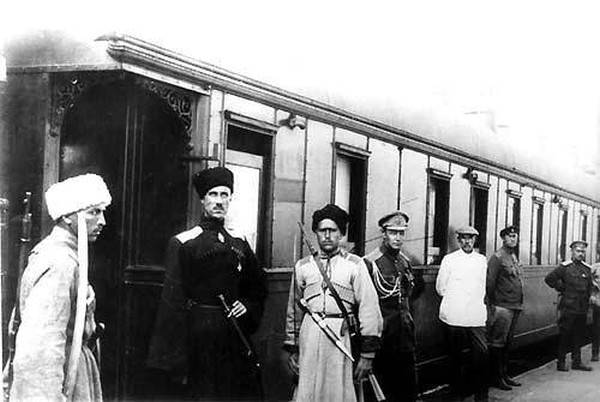
Wrangel at the staff train. 1919 year
The situation on the right flank
Having received the first alarming information about the enemy’s breakthrough in the 3 th Taman Rifle Division and the white cavalry’s departure to the rear of the Taman troops, the 4 Rifle Division commanded the defense to go. Communication with the headquarters of the 3-th Taman Division and the 11-th army was interrupted. The group of troops of the 4 th rifle division (3 rifle brigades, artillery brigade and 1 th Stavropol Cavalry Division) was isolated from the rest of the army.
To help the 7 Tamans, on January 1 of the Stavropol Cavalry Division, the task was to strike white in the area of Grateful - Vegetables. The rifle brigades remained in place, reinforced the defenses and fought off the attacks of the white detachments of generals Stankevich and Babiyev. The troops were confident that the cavalry division would strike a connection with the cavalier corps of Kochergin at Gratenoe, and thereby create conditions for the defeat of the enemy who had broken through. The Stavropol residents occupied the Vegetables, and the 10 th cavalry of Kochergin struck a sudden blow from the south and occupied the Grateful. Thus, favorable conditions were created for the attack of the Wrangel divisions that had broken to the rear of the Taman Division. Until the connection of two Soviet cavalry formations remained 20 - 30 km. The appearance of red horse groups in the village of Ovoshchi and Grateful made the White Guards somewhat delay their movement in the direction of the Holy Cross and Georgievsk.
However, the Red Command lost control and failed to use this favorable moment in order to restore the position on the front of the 11 Army. The 3-I Taman Division was in fact already defeated and was unable to deliver a strong blow towards the red cavalry. The Kochergin Corps did not receive the task for a joint strike with the Stavropol Cavalry Division over the enemy’s rear areas. As a result, Kochergin’s cavalry was soon forced to retreat to the east under the pressure of the whites. And the command of the Stavropol cavalry division acted indecisively and by January 20 had withdrawn the troops back to the 4 division. By January 17, white troops finally cut off the northern and southern parts of the 11 Army from each other.
Meanwhile, under the control of Stankevich and Babiev, the whites made a regrouping, in a stubborn battle they broke the 4-th Infantry Division, and took the Vegetables. Hundreds of Red Army soldiers who had just been mobilized surrendered and captured the ranks of the White Army. The troops of the 4 division retreated to the Divnoye, Derbetovka and Bol area. Dzhalga, where they continued to fight with the detachment of Stankevich and the cavalry brigade of General Babiev from the equestrian corps of Wrangel.
In a situation where contact with the 1 and 2 divisions and the command of the army was lost, and the left flank and rear of the 4 division was opened to attack enemy cavalry from the Holy Cross, the commanders decided to leave the Stavropol region and retire beyond. Manych, hiding behind the river. 26 - January 27 The 4 Rifle and 1 Stavropol Cavalry Divisions retired for the Manych. Fights with whites continued on the approaches to Priyutnoye, then
Behind Manych, the troops of the 11 Army met with units of the 10 Army sent back from Tsaritsyn in the fall to communicate with the Stavropol grouping. Among them were the Elista Infantry Division (up to 2 thousand bayonets) and the Chernoyarskaya Brigade (up to 800 bayonets and sabers). Thus, in the same area were part of the two armies - 10-th and 11-th, included in different fronts - South and Caspian-Caucasus. There was no connection with the headquarters of the armies and fronts, but it was necessary to decide: either to retreat to Tsaritsyn or Astrakhan, or to remain in place and continue fighting with the White Guards, trying to pull off as much of Denikin’s forces as possible. As a result, at the end of January 1919, it was decided to create a Special United Army of the Steppe Front. The forces of the Special United remained in the areas occupied by them and fought defensive battles with the Whites, who were developing the offensive from the Priyutny area on Kormovoye, Kresty and Remontnoe. At the end of February 1919, the troops of the Special United Army were transformed into the Stavropol fighting area, and remained at Manych.
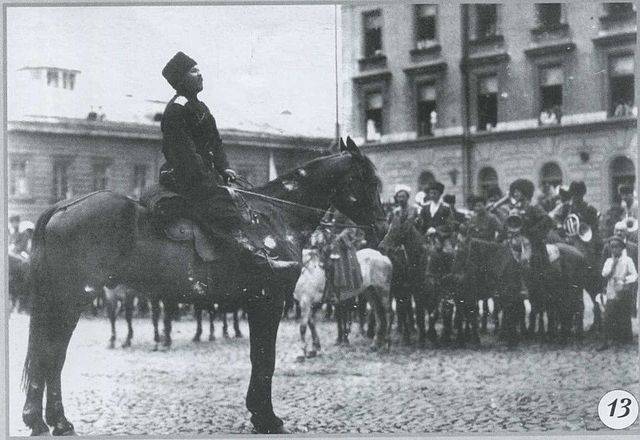
The commander of the 2 th horse brigade as part of Wrangel's horse division, then the commander of the 1 th horse division of General Wrangel's horse corps, General S. M. Toporkov at the parade of the Volunteer Army in Kharkov. 1919 year
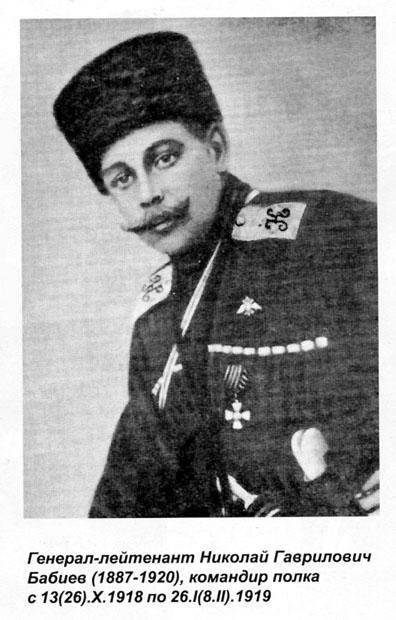
Commander of the 2 Kuban Horse Brigade in the 1 of the Kuban Cossack Division, then Commander of the 3 of the Kuban Cossack Division Nikolay Babievich
Fighting on the left flank of the 11 Army
At the same time, fierce fighting continued on the left flank of the 11 Army. The troops of 1 and 2 of the rifle divisions, having spent most of their ammunition, could not overcome the resistance of whites in the Nevinnomyssk direction and fought fierce battles with varying success in the area of Kursavka station, the villages of Borgustan and Suvorov and Kislovodsk. First, the Reds pressed the Circassian division of Sultan-Giray near Batalpashinsk. However, Shkuro mobilized all White's forces on the southern flank, repelled the attack and himself launched a counteroffensive. He managed to organize an uprising of the Cossacks in the red rear and simultaneously attacked from the rear. On January 9, the Reds retreated from Vorovskoelesky, Borgustanskaya and Suvorovskaya and retreated to Yessentuk, Kislovodsk and Kursavka, where the fierce battles continued with a new force. Both sides acted extremely cruelly. The villages, which passed from hand to hand, were badly destroyed, the red and white terror flourished. The Bolsheviks destroyed the Cossacks, and the returning Cossacks massacred non-resident supporters (peasants and other social groups not belonging to the Cossack class) who supported the Soviet power.
On January 10, the White Cossacks came very close to Kislovodsk, and raided Yessentuki, but they were rejected. January 11 The 3 Army Corps Lyakhova launched an offensive against Kursavka, Yessentuki and Kislovodsk. Skins with horse and foot militia and the Circassian division attacked Yessentuki, but met strong resistance, suffered heavy losses and retreated. 12 January Shkuro repeated the attack and took Essentuki. In the morning of 13, the Reds, with the support of an armored train, beat off the city.
However, in the conditions of the defeat of the Taman Division, the attack of the enemy on the Holy Cross and Georgievsk, the operational situation for the left flank of the 11 Army evolved unfavorably. 1 and 2 rifle divisions were threatened by encirclement. On January 12, the commander Lewandowski ordered the 1 and 2 divisions to retreat to Kislovodsk. 13 January The RVS of the 11 Army set the task for the 1 and 2 infantry divisions to hold the enemy with cavalry and, moving away, to keep the Kislovodsk, Yessentuki and Pyatigorsk areas.
13 January 1919 of the X-NUMX Army Revolutionary Army reported to Astrakhan to the headquarters of the Caspian-Caucasian Front that the situation is critical: because of an epidemic that wiped out half of the personnel, lack of ammunition and ammunition, demoralization and mass surrender to the side White mobilized units, the army at the edge of death. The number of army reduced to 11 thousand people and continues to fall. But even 20 January, the army command reported on the proximity of a decisive victory on the whites. This message did not quite correspond to reality, the southern grouping of the Reds was quite combat-worthy - the 5-I and 1-I infantry divisions retained their combat strength almost completely and by that time had at least 2 thousand bayonets, 17 thousand sabers. Kochergin's cavalry retained up to 7 thousand sabers, the Kochubey cavalry brigade was effective.
15 - On January 16, the troops of the 1 and 2 of the rifle division retreated, their rearguards beat off the fierce attacks of the enemy. 17 — January 18 Corps Lyakhov took Kursavka (during the month of fighting, the station changed hands seven times). At the same time, White got around Essentuki from the side of Cool. Fearing encirclement, the Reds left the city. The Red forces continued to retreat and on January 20 left Pyatigorsk and Mineralnye Vody. The withdrawal of rifle divisions was covered by the Kochubey and Guschina brigades, the 1 Communist Pyatigorsk Infantry Regiment, which conducted rearguard battles with the pressing Cossacks Shkuro.
Thus, the 11 Army collapsed. Ordzhonikidze believed that it was necessary to retreat to Vladikavkaz. The majority of the commanders were against it, believing that the army, pressed against the mountains and without ammunition, would die. Many separate groups, especially the Taman Division, could no longer receive orders and ran on their own. The northern flank of the army, the 4 division and other units (about 20 thousand bayonets and sabers) retreated to the north, beyond Manych, where they then formed a Special Army there.
On January 20, the army command, in view of the complete absence of ammunition, ordered the 1 and 2 divisions with the remnants of the Taman Division to retreat to the area of Prokhladnaya, Mozdok and Kizlyar, and the 4 division to go to Manych for connections with the 10 army. On January 21, after a hard two-day battle, Georgievsk was captured, cutting off the St. George group of Reds. However, after a stubborn battle, the retreating troops of the 1 and 2 rifle divisions and the Kochubey Cavalry Brigade, which had gone white in the rear, inflicted a local defeat on the advancing enemy and broke through. After that, the Reds continued their retreat to the Cool. At the same time, the retreat took a spontaneous, chaotic character, and all plans of the systematic departure of the command of the 11 Army, attempts to gain a foothold and fight the enemy failed. The personal intervention of Ordzhonikidze did not help either. The troops fled, only Kochubey's cavalry brigade in the rearguard maintained combat capability, restrained the enemy, covering infantry and carts.
On the night of January 21 in Prokhladnaya, a meeting of the army command was held, at which the question of where to retreat was decided: on Vladikavkaz - Grozny or on Mozdok - Kizlyar. Ordzhonikidze believed that it was necessary to retreat to Vladikavkaz. There, to teach the support of the mountaineers who were guided by the Soviet power, and to organize defense in the difficult mountainous region, continuing to bind Denikin’s considerable forces. The majority of the commanders were against it, believing that the army, pressed against the mountains and without ammunition, would die. As a result, contrary to the opinion of the main command, the troops spontaneously fled to Mozdok-Kizlyar. Along the way, thousands of typhus patients and wounded Red Army men remained in the abandoned cities, villages and villages. They could not evacuate them.
For example, among the left was the famous red commander Alexey Avtonomov. He was one of the most prominent red commanders in Kuban, led the defense of the Ekaterinodar harrow during the storming of the city by the Volunteer Army (First Kuban campaign), then was commander-in-chief of the North Caucasian Red Army. Due to a conflict with the CEC Kuban-Black Sea republic was dismissed from his post, recalled to Moscow. Behind him stood up Ordzhonikidze, again sent to the Caucasus as a military inspector and the organizer of the military units. He commanded a small detachment in the battles on the Terek and under the Holy Cross, and during the retreat of the defeated 11 autonomous army fell ill with typhus, was left in one of the mountain villages and died 2 on February 1919.
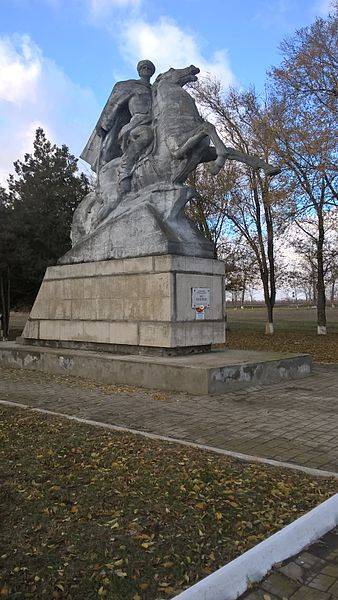
Monument to the red commander. A. Kochubeyu in the village of Beysug
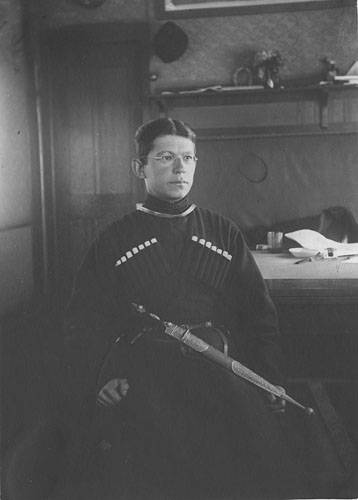
Red commander Alexey Ivanovich Avtonomov in his personal car. 1919 year. Photo source: https://ru.wikipedia.org
23 January 1919 of the year white effortlessly took Nalchik, 25-go - Cool. The command of the 11 Army left for Mozdok. On January 24, Ordzhonikidze from Vladikavkaz sent the following telegram to Lenin: “There is no 11 army. She finally decayed. The enemy occupies cities and villages with almost no resistance. At night, the question was to leave the entire Terek region and go to Astrakhan. We consider this a political desertion. No shells and cartridges. No money. Vladikavkaz, Grozny still have not received any cartridges, not a penny of money, we have been fighting a war for six months, buying cartridges of five rubles each. ” Ordzhonikidze wrote that "we will all die in an unequal battle, but we will not defame the honor of our party by fleeing." He noted that the situation could straighten out the direction of 15 - 20 thousand of fresh troops, as well as sending ammunition and money.
However, the command of the Caspian-Caucasian Front and the 12 Army did not expect such a rapid change in the situation and the catastrophe of the 11 Army. Thus, the relevant measures were not taken or were very late. The connection between Astrakhan Georgievsk was broken and the front command until January 14 was not aware of the critical situation in the 11 army. On January 25, the command of the 12 Army ordered the deployment of one regiment to defend Mozdok and Vladikavkaz, which was clearly not enough. On January 27 from Astrakhan, the 11 Army was informed that the Redskins detachment was sent to strengthen the right flank of the army in the Yashkul area, which was to gather troops of the 4 Infantry Division and organize an attack on the Holy Cross. That is, the main command at that time actually did not imagine the scale of the 11-th disaster and the situation in the North Caucasus after that.
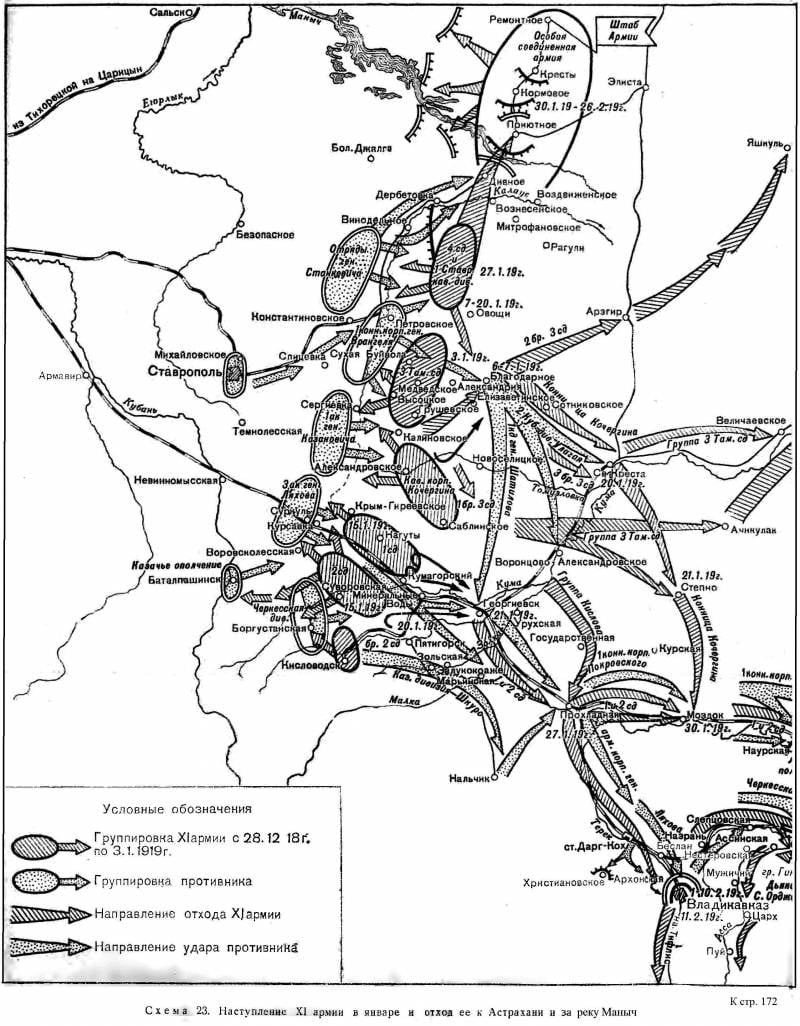
Information